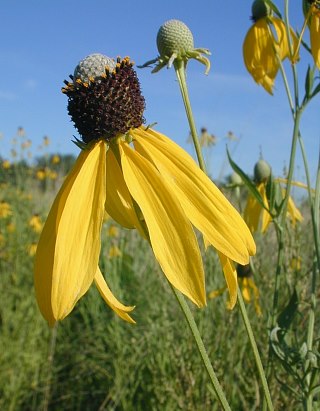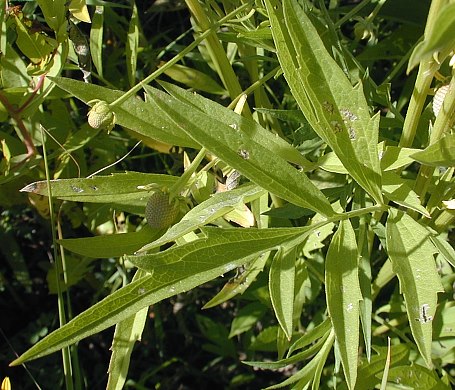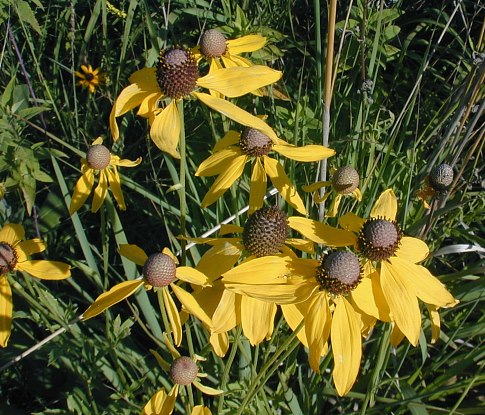Description: This herbaceous perennial plant is up to 4' tall while in flower. The long slender stems are slightly ridged. The basal leaves occur toward the bottom of these stems and are irregularly shaped – the larger leaves are pinnately divided into 3-7 lobes, sometimes subdividing further into 1-2 secondary lobes. The margins of these leaves are smooth, or sparsely dentate; they are individually up to 8" long and 5" across. The smaller leaves higher up on the stems are usually lanceolate; they are few in number. The texture of these leaves is rough as a result of tiny stiff hairs and bumps. The daisy-like composite flowers occur at the apex of the tall stems. Each composite flower has up to 13 drooping yellow ray florets spanning 1-2½" across, and an oblong head of disk florets that is about ½–¾" tall when mature. This head is initially light green or grey, but later becomes dark brown. The blooming period occurs from early to late summer, and lasts about 1-2 months. There is little or no floral scent – although the seedheads release an anise scent when they are crushed. The root system is rhizomatous, often forming tight clumps of plants. The dark achenes are without tufts of hair.

Cultivation:
The preference is full sun, mesic conditions, and a loam or clay-loam
soil. However, this is a robust plant that will tolerate partial sun,
moist to slightly dry conditions, and many kinds of soil. Foliar
disease doesn't affect the leaves until after the blooming period.
There is a tendency for the flowering stems to flop around if this
plant is spoiled by too much water or fertile soil. This plant is easy
to grow.
Range & Habitat:
The native Yellow Coneflower is fairly common in Illinois, except in
some SE
counties (see Distribution
Map). Habitats include moist to slightly dry black soil
prairies, clay prairies, thickets, woodland borders, limestone glades,
and areas along railroads, particularly where remnant prairies occur.
Yellow Coneflower tends to colonize the more disturbed areas of these
habitats.

Faunal Associations: Many kinds of insects visit the flowers, but especially bees, including Epeoline Cuckoo bees, large Leaf-Cutting bees, Green Metallic bees, and other Halictine bees. Other insect visitors include wasps, flies, small butterflies, and beetles. These insects suck nectar from the flowers, although the bees also collect pollen and some beetles feed on pollen. The caterpillars of the butterfly Chlosyne nycteis (Silvery Checkerspot) feed on Yellow Coneflower, as well as the caterpillars of the moths Eynchlora acida (Wavy-Lined Emerald) and Eupithecia miserulata (Common Eupithecia). Goldfinches occasionally eat the seeds, while some mammalian herbivores eat the foliage and flowering stems, particularly groundhogs and livestock.

Photographic
Location:
Photographs were taken at a prairie of Parkland College in Champaign,
Illinois.
Comments:
Yellow Coneflower is an excellent choice for a wildflower garden
because of its long blooming period and attractive yellow flowers. The
entire plant is delicately constructed, and has a tendency to sway or
flutter with each passing breeze. This species can be distinguished
from other yellow coneflowers, such as Rudbeckia hirta,
by its drooping ray florets and the complex structure of the basal
leaves.